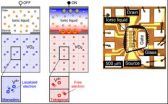(Press-News.org) This press release is available in German.
Leipzig. The carcinogenic harmful substance benzene can seriously impact the soil and ground water following chemical accidents or at old industrial sites. Nevertheless, bacteria exist which can degrade this compound even in the absence of oxygen. Until now it was not clear which organisms take part in this process and how they work together. With modern analytical procedures scientists of the Helmholtz Centre for Environmental Research (UFZ) have succeeded for the first time in tracking the path of this harmful substance through such a bacterial community with proteins. Accordingly, three teams of microbial harmful substance eliminators cooperate, each with its own tasks. In the professional publication ISME Journal, jointly issued by the Nature Publishing Group and the International Society for Microbial Ecology, the researchers say that this method could also help to clarify the complex processes in other bacterial cooperatives.
On the premises of the former Zeitz hydrogenation plant in Saxony-Anhalt traces of chemicals from earlier times are still present. The plant began the extraction of liquid fuels and lubricants from lignite in 1938. When the allied forces bombed and largely destroyed the plant in the final months of the Second World War, large amounts of harmful substances seeped into the ground and into the ground water. Further impacting came during the era of East Germany when Zeitz developed to a centre for the processing of coal and crude oil. In the meantime the old production facilities have been torn down and the required restoration work is continuing under the direction of the federal state of Saxony-Anhalt. However, residual contamination, particularly in the deeper areas, will remain. In the sediment and ground water, above all a group of compounds is found which chemists refer to by the abbreviation BTEX. This stands for the highly volatile aromatic compounds benzene, toluene, ethyl benzene and xylene. Particularly benzene can be detected in relevant concentrations.
Benzene a "hot" harmful substance
Benzene is of special significance for the environment, because this compound is carcinogenic and damaging to the central nervous system. Higher concentrations can lead to unconsciousness and respiratory paralysis and can be damaging to health even in low concentrations.
A variety of products from plastics and resins to pesticides and paints derives from benzene. Furthermore, it is also an important component of petrol. Thus, there are many sources of pollution. Benzene can penetrate into the environment as a result of chemical accidents and is also found in the areas surrounding oil refineries and tank storage facilities, petrol stations and well-travelled roads. Consequently, for many years researchers from the UFZ have been investigating the possibilities for the remediation of such impacted areas. This is also of interest for other areas. "In Germany, to be sure, for many years the problems caused by this harmful substance have been declining", says Martin von Bergen, Head of the Proteomics Department at the UFZ. Nevertheless, this in no way applies for other countries, as this expert is aware: "In China, for example, pollution is increasing dramatically". Thus, in November 2005 around 100 tonnes of benzene flowed into the Songhua River, following an accident in a chemical plant. This resulted in a toxic plume 80 kilometres long and reached the city of Harbin, with a population of several million, making the interruption of the supply of drinking water to the city necessary.
Nevertheless, bacteria exist which can degrade such pollution again. Provided that there is a sufficient supply of oxygen, this takes place relatively quickly. However, when the substance seeps into the ground it soon reaches regions with only little oxygen or none at all. "And no one knows exactly what happens there", says Martin von Bergen. It is in fact clear that degradation still takes place, even in the absence of oxygen, as earlier studies at the UFZ in which, above all, scientists of the Department of Isotope Biogeochemistry collaborated, have shown. Biochemists can explain part of this process relatively well. However, the first step of the biological attack against benzene remains a mystery so far. Indeed, until recently researchers had only limited conceptions of the bacteria taking part and their respective tasks.
Search for evidence in the microbial sphere
This has now changed. For the first time the new study, in which scientists of the Departments of Soil Ecology, Environmental Microbiology, Isotope Biogeochemistry and Proteomics collaborated, showed a rather detailed picture of the benzene eliminator community. "This was not a question of identifying every single type taking part", explains Martin von Bergen. This is generally difficult with environmental samples, because many of the types taking part have not yet even been described. Moreover, in the microbial realm "type" is a rather vague concept posing difficulties even for experts.
On the other hand, we can readily differentiate between groups having different functions. "Bacteria are team players", explains Martin von Bergen. Just as there are specialists for management, bookkeeping or production within a company, the degradation of benzene requires the cooperation of microorganisms with different talents. Whether or not one or several types serve to perform a given task is of secondary importance. Important is that the job gets done.
In order to investigate the nature of this division of tasks amongst the microbial benzene fans the researchers took samples of impacted underground water from Zeitz for analysis in the laboratory. There they subjected the proteins of the organisms to a so-called isotopic analysis. This procedure is based on the existence of two different highly stable carbon variants in nature. The lighter and far more frequently occurring of these isotopes is known as 12C and the heavier as 13C. The researchers offered the bacteria benzene molecules in which the heavier version was significantly enriched. They then investigated the extent to which the organisms incorporated this isotope in their proteins. This was determined by analysing fragments of the proteins with a mass spectrometer.
The harmful substance eliminator team
"This investigation provides us with two interesting types of information", explains Martin von Bergen. On the one hand, by comparing with databases we can determine the bacterial groups to which the protein fragments belong. In order to verify these results, the researchers also utilised modern methods to cast a glance into the genetic material of the microbe crew. "In this way, we were able to gain a genetic overview of the members of the bacterial community", says the UFZ researcher.
However, the second result of the isotopic analyses was still more interesting, as these analyses reveal information about the metabolism of the individual organisms. Decisive here is the amount of 13C found in the proteins as a function of time. "Here there are typical patterns, according to the source of nutrition", explains Martin von Bergen. Thus, the researchers succeeded in identifying a group of bacteria in which the 13C content immediately rises and then hardly increases any more. These microbes feed directly on 13C benzene. In a second group, on the other hand, larger concentrations of the isotope in the proteins are found only over a longer period of time. These organisms do not feed directly on the harmful substance itself, but live from its degradation products. Finally, there is also a third group, in which the 13C concentration remains at a low level over the entire time. These are presumably scavengers, which live from the remains of other bacteria.
"We have therefore succeeded in tracking the path of benzene atoms through the entire bacterial community", says Martin von Bergen proudly. The researchers have not only discovered who ingests what in which amounts. They now know more about how the co-operation between the different teams of bacteria functions. Thus, the directly feeding bacteria for the degradation of benzene presumably produce both acetate and hydrogen. However, they must release both substances, as these would otherwise inhibit their metabolism. Here the organisms of the second group, which feed only indirectly on the harmful substance, come to their aid by utilising the acetate as a source of carbon and eliminating the hydrogen.
A new look at sewage sludge and the intestinal tract
"Such co-operations of course not only exist amongst benzene eliminators", says Martin von Bergen. With the aid of their methods he and his colleagues hope to be able to analyse other complex bacterial communities. For example, it would be possible to investigate the co-operation of different microbes in biogas plants or in sewage sludge. An understanding of these processes would make better control of the processes possible in such plants. Such investigations can also furnish new knowledge for medicine. One knows, for example, that thin persons have other
microorganisms in the gastrointestinal tract than obese persons. In addition, the bacterial flora also appear to influence the immune system. One would like to know more about all of these relationships in order to help people lose weight or reinforce their natural defences, for example.
"Bacterial communities live everywhere, from the flower pot to within the human body", Martin von Bergen sums up. Previously microbiologists investigated above all which organisms occur where. However, now they want to know more about their activities and co-operations. For Martin von Bergen and his colleagues this "functional biodiversity" is a promising subject for future research. These exciting approaches could also play a role within the scope of the new Biodiversity Research Centre of the German Research Foundation (DFG), with the joint participation of the Universities of Leipzig, Halle and Jena and the UFZ.
INFORMATION:
Kerstin Viering
Publication:
Martin Taubert, Carsten Vogt, Tesfaye Wubet, Sabine Kleinsteuber, Mika T. Tarkka, Hauke Harms, François Buscot, Hans-Hermann Richnow, Martin von Bergen and Jana Seifert (2012): Protein-SIP enables time-resolved analysis of the carbon flux in a sulfate-reducing, benzene-degrading microbial consortium. The ISME Journal advance online publication, 12 July 2012; doi:10.1038/ismej.2012.68 http://www.nature.com/ismej/journal/vaop/ncurrent/full/ismej201268a.html
The studies were supported by the Deutsche Forschungsgemeinschaft (DFG) through the priority program "Biological reactions of hydrocarbons in the absence of oxygen: from molecular to global scale (1319)" program. (http://www.helmholtz-muenchen.de/spp1319/)
Further Information:
Helmholtz Centre for Environmental Research (UFZ)
Dr. Jana Seifert/ PD Dr. Martin von Bergen, Department of Proteomics
Phone: +49-341-235-1352, -1211
http://www.ufz.de/index.php?en=17612
http://www.ufz.de/index.php?en=17634
Dr. Hans-Hermann Richnow, Department Isotope Biogeochemistry
Phone: +49-341-235-1212
http://www.ufz.de/index.php?en=10650
Prof. Hauke Harms, Department of Environmental Microbiology
Phone: +49-341-235-1260
http://www.ufz.de/index.php?en=1443
Prof. Francois Buscot, Department of Soil Ecology
Phone: +49-345-5585-221
http://www.ufz.de/index.php?en=7005
or via
Tilo Arnhold (UFZ Press Office)
Phone: +49-341-235-1635
www.ufz.de/index.php?en=640
Links:
Protein stable-isotope probing (Protein-SIP) for functional metaproteomics
http://www.ufz.de/index.php?en=20157
Teamwork against Benzene
2012-07-26
ELSE PRESS RELEASES FROM THIS DATE:
New stroke treatments becoming a reality
2012-07-26
Scientists led by the President of The University of Manchester have demonstrated a drug which can dramatically limit the amount of brain damage in stroke patients.
Professor Dame Nancy Rothwell, Professor Stuart Allan and their team have spent the last 20 years investigating how to reduce damage to the brain following a stroke.
They have been testing the effectiveness of the drug Anakinra (IL-1Ra), which is already used for rheumatoid arthritis in experimental studies of stroke.
This new study builds on previous research, although the big difference is that rats ...
Switching the state of matter
2012-07-26
Sixty years after the transistor began a technological revolution that transformed nearly every aspect of our daily lives, a new transistor brings innovations that may help to do so again. Developed at RIKEN, the device uses the electrostatic accumulation of electrical charge on the surface of a strongly-correlated material to trigger bulk switching of electronic state. Functional at room temperature and triggered by a potential of only 1 V, the switching mechanism provides a novel building block for ultra low power devices, non-volatile memory and optical switches based ...
A pulsar with a tremendous hiccup
2012-07-26
This press release is available in German.
Pulsars are superlative cosmic beacons. These compact neutron stars rotate about their axes many times per second, emitting radio waves and gamma radiation into space. Using ingenious data analysis methods, researchers from the Max Planck Institutes for Gravitational Physics and for Radio Astronomy, in an international collaboration, dug a very special gamma-ray pulsar out of data from the Fermi Gamma-ray Space Telescope. The pulsar J1838-0537 is radio-quiet, very young, and, during the observation period, experienced the strongest ...
New biomarker for common lung cancer predicts responses to chemotherapy
2012-07-26
Patients with the most common type of lung cancer are notoriously insensitive to chemotherapy drugs, including cisplatin. New findings related to the cellular pathways that regulate responses to cisplatin have now been published by Cell Press on July 26th in the journal Cell Reports. The findings reveal a potential biomarker that can be used to predict how these patients will respond to chemotherapy, as well as the patients' overall prognosis, paving the way for personalized treatment strategies.
Non-small cell lung cancer (NSCLC) is one of the leading causes of cancer-related ...
Methane measurements at low level flight
2012-07-26
A team of scientists from the Alfred Wegener Institute for Polar and Marine Research in the Helmholtz Association (AWI) and the GFZ German Research Centre for Geosciences has just completed an airborne measurement campaign that allowed for the first time to measure large-scale methane emissions from the extensive Arctic permafrost landscapes. The study area extended from Barrow, the northernmost settlement on the American mainland, across the entire North Slope of Alaska, to the Mackenzie Delta in the Northwest Territories of Canada. The airborne measurements (Airborne ...
Unprecedented accuracy in locating brain electrical activity with new device
2012-07-26
Researchers at Aalto University in Finland have developed the world's first device designed for mapping the human brain that combines whole-head magnetoencephalography (MEG) and magnetic resonance imaging (MRI) technology. MEG measures the electrical function and MRI visualizes the structure of the brain. The merging of these two technologies will produce unprecedented accuracy in locating brain electrical activity non-invasively.
We expect that the new technology will improve the accuracy of brain mapping of patients with epilepsy. It may also improve the diagnosis of ...
DNA damage in roofers due to PAH exposure – possible cancer link
2012-07-26
Roofers and road construction workers who use hot asphalt are exposed to high levels of polycyclic aromatic hydrocarbons (PAHs). A University of Colorado Cancer Center study published this week in the British Medical Journal Open shows that roofers have higher PAH blood-levels after a shift than before and that these high levels of PAHs are linked with increased rates of DNA damage, and potentially with higher cancer risk.
"We've known for some time that roofers and road workers have higher cancer rates than the general population, but we also know roofers have a higher ...
Deadly E. coli strain decoded
2012-07-26
EAST LANSING, Mich. — The secret to the deadly 2011 E. coli outbreak in Germany has been decoded, thanks to research conducted at Michigan State University.
The deadliest E. coli outbreak ever, which caused 54 deaths and sickened more than 3,800 people, was traced to a particularly virulent strain that researchers had never seen in an outbreak before. In the current issue of the academic journal PLoS ONE, a team of researchers led by Shannon Manning, MSU molecular biologist and epidemiologist, suggests a way to potentially tame the killer bacteria.
The strain, E. coli ...
'Basarab' surname may not indicate direct relation to Vlad the Impaler
2012-07-26
WASHINGTON—A study by the Genographic Project has shown that not all individuals carrying the Romanian "Basarab" surname, the first dynasty of Wallachian kings that included the real-life Dracula, can be direct biological descendants of the Basarab dynasty.
The Basarab dynasty ruled Wallachia, the historical and geographical southern region of present-day Romania, for almost three centuries (1330-1601) and had among its members Vlad III the Impaler, commonly known as Dracula. The ethnic origin of the Basarab family has long been a dispute among historians, with both an ...
Should high-dose interleukin-2 continue to be the treatment of choice for metastatic melanoma?
2012-07-26
New Rochelle, NY, July 26, 2012— Administering high-doses of interleukin-2 (IL-2) has been the preferred treatment for patients with stage IV metastatic melanoma. An article published in the current issue of Cancer Biotherapy and Radiopharmaceuticals, a peer-reviewed journal from Mary Ann Liebert, Inc. (http://www.liebertpub.com), explores whether or not this regimen is still the most effective. The article is available free online at the Cancer Biotherapy and Radiopharmaceuticals website (http://www.liebertpub.com/cbr).
In the article "Should High-Dose Interleukin-2 ...




